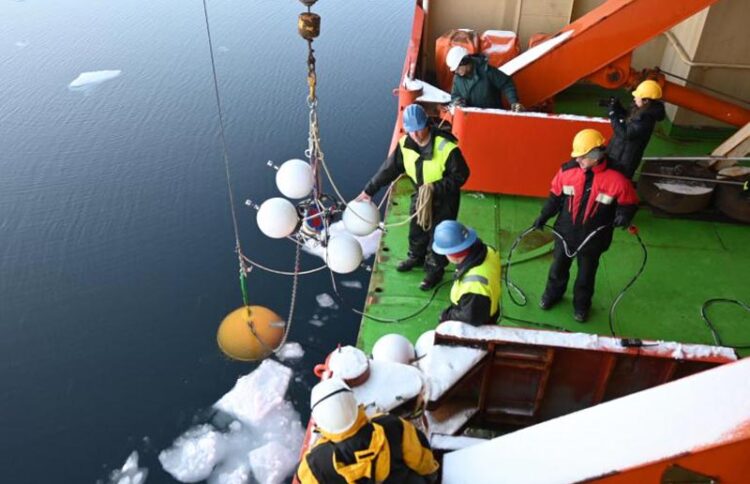New research explains “Atlantification” of the Arctic Ocean

Crew abroad the research vessel Akademik Tryoshnikov hoist science instrumentes in a 2021 science cruise. Photo courtesy of Igor Polyakov
New research by an international team of scientists explains what’s behind a stalled trend in Arctic Ocean sea ice loss since 2007. The findings indicate that stronger declines in sea ice will occur when an atmospheric feature known as the Arctic dipole reverses itself in its recurring cycle.
The many environmental responses to the Arctic dipole are described in a paper published online today in the journal Science. This analysis helps explain how North Atlantic water influences Arctic Ocean climate. Scientists call it Atlantification.
The research is led by professor Igor Polyakov of the University of Alaska Fairbanks College of Natural Science and Mathematics. He is also affiliated with the International Arctic Research Center at UAF.
Co-authors include Andrey V. Pnyushkov, research assistant professor at the International Arctic Research Center; Uma S. Bhatt, atmospheric sciences professor at the UAF Geophysical Institute and UAF College of Natural Science and Mathematics; and researchers from Massachusetts, Washington state, Norway, and Germany.
“This is a multidisciplinary view on what’s going on in the Arctic and beyond,” Polyakov said of the new research. “Our analysis covered the atmosphere, ocean, ice, changing continents and changing biology in response to climate change.”
A wealth of data, including direct instrumental observations, reanalysis products and satellite information going back several decades, shows that the Arctic dipole alternates in an approximately 15-year cycle and that the system is probably at the end of the present regime.
In the Arctic dipole’s present “positive” regime, which scientists say has been in place since 2007, high pressure is centered over the Canadian sector of the Arctic and produces clockwise winds. Low pressure is centered over the Siberian Arctic and features counterclockwise winds.
This wind pattern drives upper ocean currents, with year-round effects on regional air temperatures, atmosphere-ice-ocean heat exchanges, sea-ice drift and exports, and ecological consequences.
The authors write that, “Water exchanges between the Nordic seas and the Arctic Ocean are critically important for the state of the Arctic climate system” and that sea ice decline is “a true indicator of climate change.”
In analyzing oceanic responses to the wind pattern since 2007, the researchers found decreased flow from the Atlantic Ocean into the Arctic Ocean through the Fram Strait east of Greenland, along with increased Atlantic flow into the Barents Sea, located north of Norway and western Russia.
The new research refers to these alternating changes in the Fram Strait and the Barents Sea as a “switchgear mechanism” caused by the Arctic dipole regimes.
The researchers also found that counterclockwise winds from the low-pressure region under the current positive Arctic dipole regime drive freshwater from Siberian rivers into the Canadian sector of the Arctic Ocean.
This westward movement of freshwater from 2007 to 2021 helped slow the overall loss of sea ice in the Arctic compared to 1992 through 2006. The freshwater layer’s depth increased, making it too thick and stable to mix with the heavier saltwater below. The thick layer of freshwater prevents the warmer saltwater from melting sea ice from the bottom.
The authors write that the switchgear mechanism regulating inflows of sub-Arctic waters has “profound” impacts on marine life. It can lead to potentially more suitable living conditions for sub-Arctic boreal species near the eastern part of the Eurasian Basin, relative to its western part.
“We are beyond the peak of the currently positive Arctic dipole regime, and at any moment it could switch back again,” Polyakov said. “This could have significant climatological repercussions, including a potentially faster pace of sea-ice loss across the entire Arctic and sub-Arctic climate systems.”
The research was funded by the U.S. National Science Foundation and the U.S. Office of Naval Research.
CONTACTS:
• Igor Polyakov, International Arctic Research Center, 907-474-2686, ivpolyakov@alaska.edu
• Rod Boyce, University of Alaska Fairbanks Geophysical Institute, 907-474-7185, rcboyce@alaska.edu
Journal: Science
DOI: 10.1126/science.adh515
Method of Research: Meta-analysis
Article Title: Fluctuating Atlantic inflows modulate Arctic atlantification
Article Publication Date: 31-Aug-2023
Media Contact
Rod Boyce
University of Alaska Fairbanks
rcboyce@alaska.edu
Office: 907-474-7185
All latest news from the category: Earth Sciences
Earth Sciences (also referred to as Geosciences), which deals with basic issues surrounding our planet, plays a vital role in the area of energy and raw materials supply.
Earth Sciences comprises subjects such as geology, geography, geological informatics, paleontology, mineralogy, petrography, crystallography, geophysics, geodesy, glaciology, cartography, photogrammetry, meteorology and seismology, early-warning systems, earthquake research and polar research.
Newest articles

Sea slugs inspire highly stretchable biomedical sensor
USC Viterbi School of Engineering researcher Hangbo Zhao presents findings on highly stretchable and customizable microneedles for application in fields including neuroscience, tissue engineering, and wearable bioelectronics. The revolution in…

Twisting and binding matter waves with photons in a cavity
Precisely measuring the energy states of individual atoms has been a historical challenge for physicists due to atomic recoil. When an atom interacts with a photon, the atom “recoils” in…

Nanotubes, nanoparticles, and antibodies detect tiny amounts of fentanyl
New sensor is six orders of magnitude more sensitive than the next best thing. A research team at Pitt led by Alexander Star, a chemistry professor in the Kenneth P. Dietrich…





















